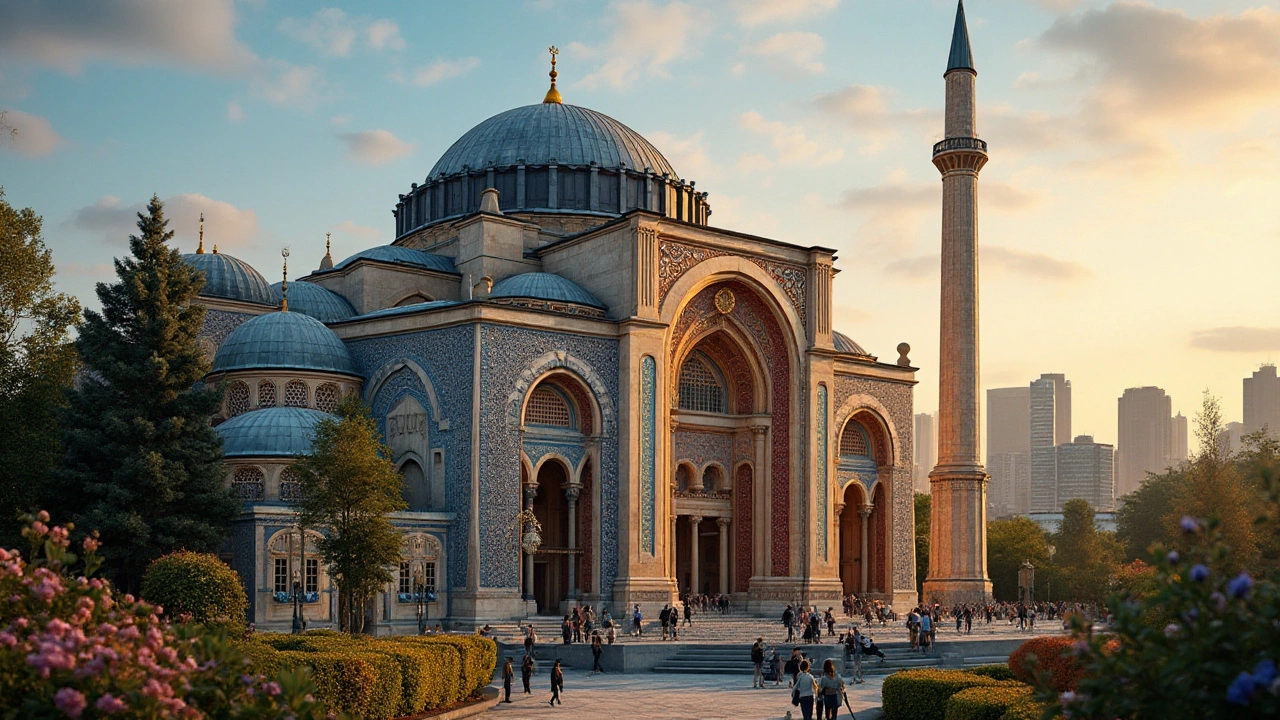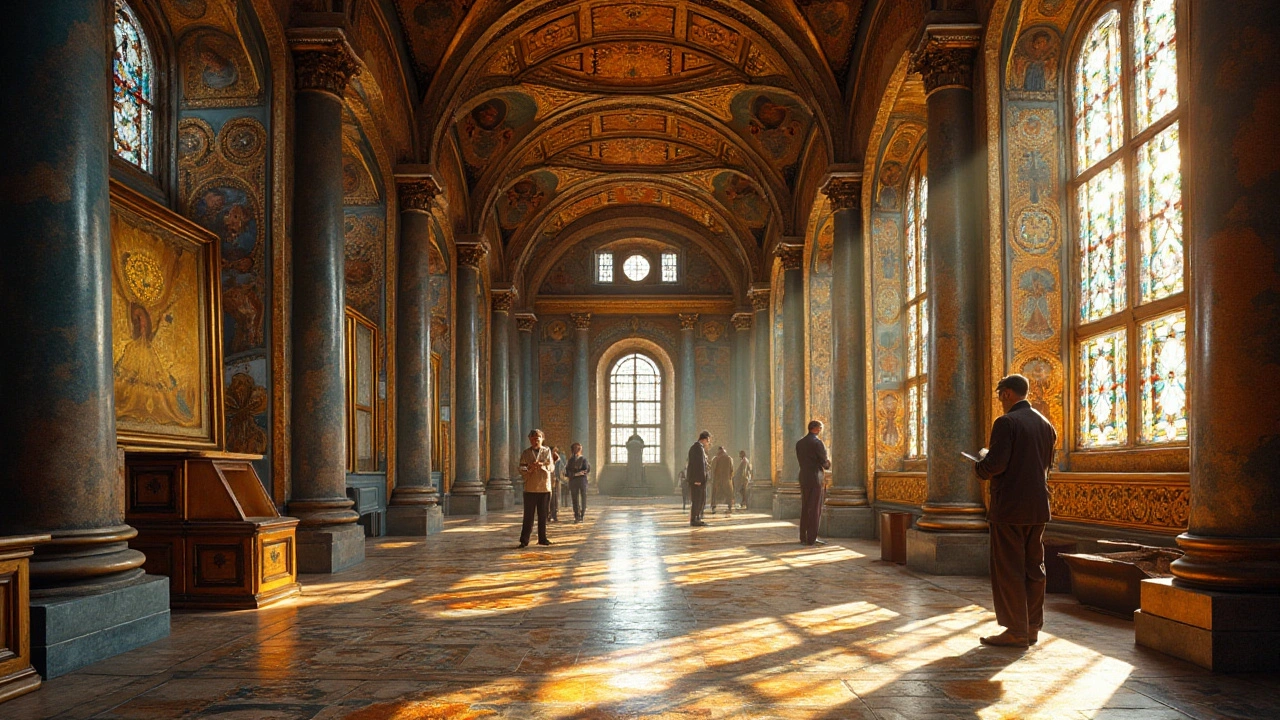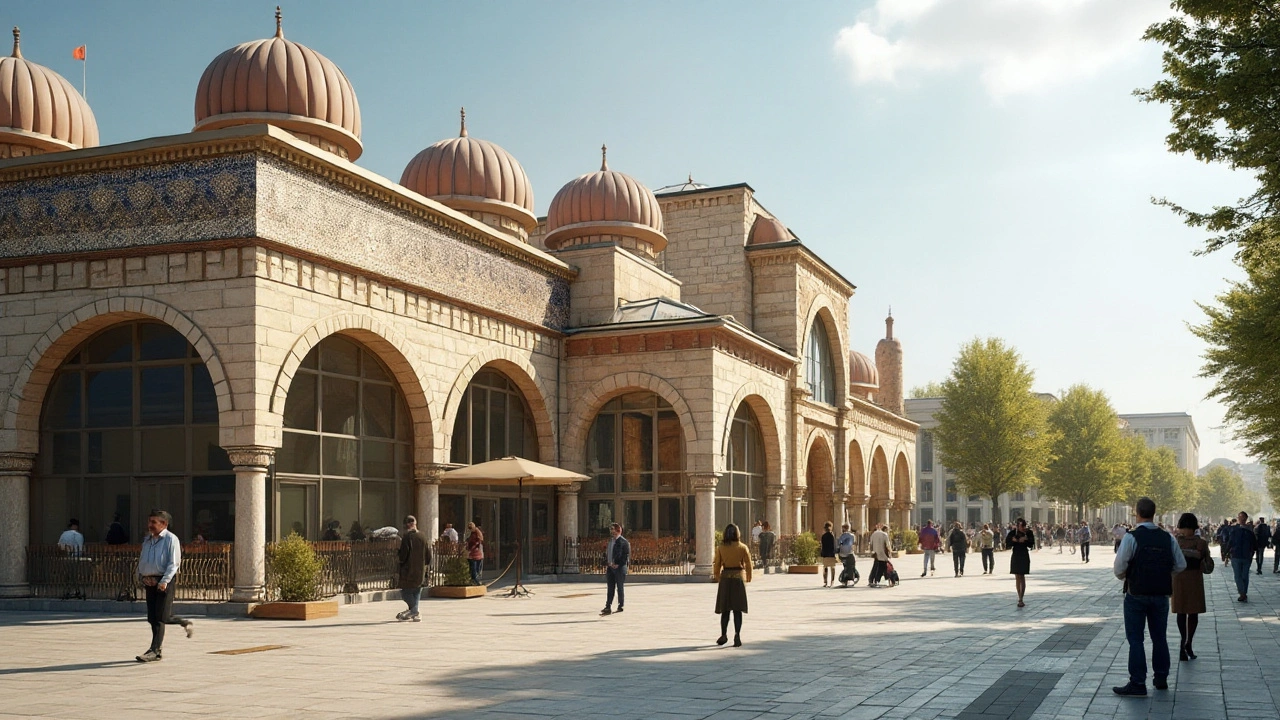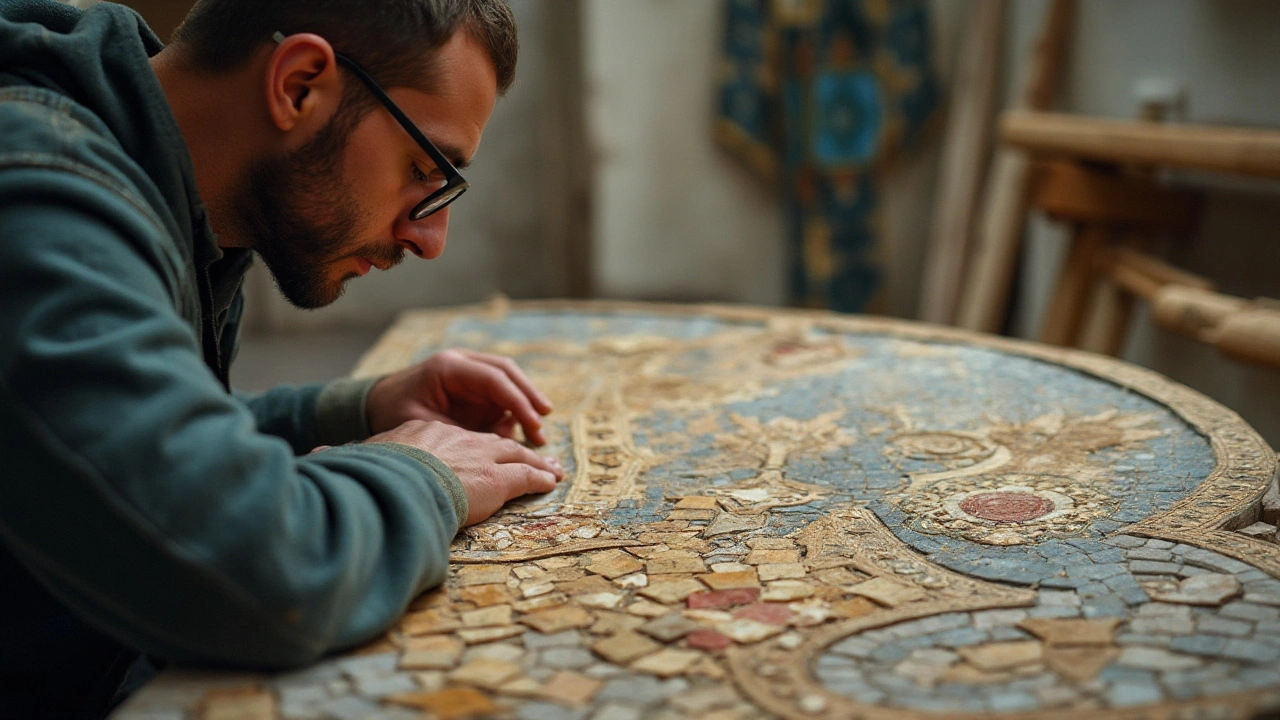Bringing Back the Majesty of Byzantine Architecture
 Sep, 23 2024
Sep, 23 2024
Byzantine architecture stands as a testament to the grandeur and spiritual depth of a civilization that spanned from the 4th to the 15th century. It is known for its vast domes, grandiose mosaics, and richly decorated interiors.
The journey into the world of Byzantine architecture starts with understanding its origins and historical significance. From the majestic Hagia Sophia in Istanbul to the Monastery of Hosios Loukas in Greece, these structures serve as milestones of architectural ingenuity.
Moving on, you will find a deep dive into the distinctive features that set Byzantine architecture apart - the iconic domes, the extensive use of mosaics, and the cross-in-square plan. These elements not only define aesthetics but also embody the spiritual ethos of the era.
This article also discusses modern techniques for restoring and preserving these ancient marvels. Practical tips and expert advice on materials and processes will provide valuable insights for anyone planning to undertake a restoration project.
Finally, the article explores how Byzantine architectural principles can be seamlessly incorporated into contemporary designs. Whether you are an architect or simply a lover of history, you will find valuable ideas on bringing a touch of Byzantium into the present day.
- History and Origins
- Unique Architectural Elements
- Renovation and Preservation Techniques
- Incorporating Byzantine Design in Modern Buildings
History and Origins
Byzantine architecture has its roots in the capital of the Byzantine Empire, Constantinople, which is known today as Istanbul. The empire itself emerged as the Eastern Roman Empire's culturally and administratively distinct successor, flourishing from around 330 to 1453 AD. The city of Constantinople was a bustling hub of commerce, culture, and politics, and its architecture mirrored its importance.
The early phase of Byzantine architecture was heavily influenced by Roman engineering techniques, but it gradually evolved its own unique style. The Roman Basilica, characterized by its large rectangular halls, provided the blueprint for many early Byzantine churches. Over time, the rigid lines of Roman design gave way to more complex, intricate forms, especially as architects began to experiment with domes.
One of the most iconic examples of early Byzantine architecture is the Hagia Sophia, which was constructed under the orders of Emperor Justinian I and completed in 537 AD. Its massive dome, which seems to float high above the central nave, was considered an engineering marvel of its time. Procopius, a contemporary historian, wrote, "It is as if one might say that the dome suspends from the heavens by the golden chain." This quote captures the awe that Hagia Sophia inspired — a feeling that endures to this day.
Unlike Roman architecture, which often relied on columns and arches for structural integrity, Byzantine architects pioneered the use of pendentives. These triangular segments of a sphere allowed for the placement of a circular dome over a rectangular room, and they became a hallmark of Byzantine design. This architectural innovation enabled the creation of expansive, open interiors, with high ceilings that drew the eyes heavenwards.
Byzantine architecture did not limit itself to grand structures like the Hagia Sophia. Smaller, local churches, monasteries, and even public buildings showcased elements of this style. The cross-in-square plan became particularly popular, influencing buildings far beyond the empire's borders. It was characterized by a square center surrounded by four equal arms, and often topped with a central dome.
The influence of Byzantine architecture was not confined to its geographical borders. Its impact can be seen in Russia, the Balkans, and even parts of Italy. For example, Saint Mark's Basilica in Venice features numerous Byzantine elements, including its iconic mosaics and domes. The spread of these architectural ideas was facilitated by the movement of craftsmen and the exchange of cultural and religious ideas along trade routes.
What truly sets Byzantine architecture apart is its seamless integration of art and structure. Mosaics adorned with intricate patterns and religious iconography covered the walls and ceilings of many buildings. These artworks weren't merely decorative; they conveyed theological concepts and served to inspire awe and reverence among worshippers. The use of light, often softened by translucent alabaster windows, created a mystical ambiance within these sacred spaces.
As the Byzantine Empire approached its decline, its architectural legacies continued to thrive. Some of the last great constructions of the Byzantine era include the Chora Church and the monasteries of Meteora, completed in the late Byzantine period but still showcasing the characteristic elements of this style. Despite the political turmoil that marked its last centuries, the architectural language of Byzantium remained a powerful cultural force.
In sum, the history and origins of Byzantine architecture reveal a complex interplay of cultural influences, innovative engineering, and artistic expression. These timeless elements continue to inspire architects and historians alike, offering a rich tapestry of designs to be rediscovered and revered. Like the golden mosaics that adorn its ancient walls, the legacy of Byzantine architecture remains luminous and enduring.

Unique Architectural Elements
Byzantine architecture is recognizable for several unique features that have not only stood the test of time but also continue to inspire modern designs. One of the most remarkable elements is the use of large domes. The dome of Hagia Sophia in Istanbul is perhaps the most famous example, with its impressive diameter and height that seem to defy gravity. These domes often sit on a square base, creating a sense of vertical grandeur and spatial dynamism.
Another significant feature is the extensive use of mosaics. Byzantine artists created intricate mosaics using tiny pieces of glass, stone, or clay to depict religious scenes or intricate geometric patterns. These mosaics were not just decorative; they imbued spaces with a sense of divine presence. The shimmering effect of light on these surfaces created an almost otherworldly atmosphere. These works of art can still be seen today in places like the Monastery of Hosios Loukas in Greece, where they remain in excellent condition.
Byzantine structures often employ the cross-in-square plan, a specific architectural layout that allows for a central dome surrounded by four other smaller domed sections. This layout creates both symmetry and balance, and it reflects theological concepts of the universe and the divine order. The harmonious design of these buildings was meant to elevate the spirit and provide a physical representation of heavenly order.
The use of pendentives is another hallmark of Byzantine architecture. These are triangular sections of vaulting that allow the circular base of a dome to sit atop a square room. This innovative solution solved several architectural challenges and allowed for the creation of larger and more stable domes. The Hagia Sophia is again an excellent example, where pendentives are expertly employed to support the massive central dome.
Structurally, Byzantine architects were pioneers in the use of brick and mortar. While stone was still prevalent, the flexibility of brick allowed for more creative and intricate designs. The combination of brick and stone, often set in decorative patterns, added both strength and aesthetic appeal to their buildings. This technique can be seen in the Church of San Vitale in Ravenna, Italy, which features a complex interplay of materials and designs.
Architectural revival efforts today often look to these unique elements for inspiration. Modern architects might not replicate the exact forms, but they draw upon the innovations and aesthetic principles that defined the Byzantine era. For example, the use of natural light to create a sense of divinity within a space is a concept that many contemporary churches and even secular buildings now embrace.
"The Byzantine architectural legacy is a testament to human ingenuity and our desire to connect with the divine through built form," says Dr. Katherine Rinne, professor of architectural history.Understanding these elements not only helps us appreciate the genius of Byzantine builders but also provides us with timeless principles that can enhance modern design. Whether you're restoring an ancient structure or creating something new, the lessons of Byzantine architecture offer invaluable insights into the art and science of building.

Renovation and Preservation Techniques
Reviving the glory of Byzantine architecture isn't merely about aesthetic appeal; it is a diligent process requiring precision, historical awareness, and respect for the original design. The first step in renovating a historic Byzantine building involves a meticulous assessment of the structure's current state. This includes evaluating the building's materials, the integrity of its domes and walls, and the condition of its iconic mosaics.
One notable restoration project is the revival of Hagia Sophia in Istanbul. Over the centuries, this architectural masterpiece has faced numerous challenges including earthquakes and changes in religious function. The recent restoration efforts are focused on stabilizing the structure while preserving its historical integrity. This includes reinforcing the vast dome using modern materials that are compatible with ancient brickwork. It also involves painstakingly cleaning and restoring the mosaics, which depict religious figures and scenes that are integral to the building's character.
"Preserving the past while embracing the future is the key to successful renovation," says Dr. Maria Yatromanolakis, an expert in Byzantine studies. "The use of materials that both respect the original construction and add longevity is essential."In addition to structural analysis and material compatibility, environmental factors also play a significant role. By understanding the climate and pollution levels surrounding the building, architects can choose the right materials for long-term preservation. For example, breathable lime-based mortars are often used to prevent moisture buildup, which can lead to damaging mold and mildew.
Modern technology offers several advanced techniques for renovation. Ground-penetrating radar (GPR) and 3D scanning are commonly employed to understand the underlying issues without causing damage to the structure. These technological tools help identify voids and cracks that aren't visible to the naked eye, allowing for targeted interventions that strengthen the building without altering its appearance.
When dealing with the preservation of mosaics, expert craftspeople often use a combination of traditional and modern techniques. Traditional methods such as tesserae replacement are combined with modern adhesives and sealants to ensure both authenticity and durability. The mosaics are often cleaned using gentle micro-scrubbing techniques to avoid damaging the delicate surfaces.
Byzantine architecture demands a high level of craftsmanship and attention to detail. Modern craftsmen must be trained in ancient techniques, often apprenticing with masters who have dedicated their lives to the art. This ensures that the original methods are not lost to time and remain a living tradition. The goal is to blend the old with the new in a way that is harmonious, with a deep respect for the original architects and artists who conceived these timeless works.
Public awareness and involvement also play a crucial role in preservation efforts. Many restoration projects are funded by donations and public grants. By integrating educational programs and guided tours, historical sites can generate revenue while educating the public about the importance of preserving historical buildings.
| Technique | Description |
|---|---|
| Ground-Penetrating Radar (GPR) | Allows for the identification of structural issues without invasive measures. |
| 3D Scanning | Provides detailed imagery of the building's current state. |
| Tesserae Replacement | Traditional method for restoring mosaics using individually cut pieces of stone, glass, or other materials. |
| Micro-Scrubbing | Gentle cleaning technique for delicate surfaces. |
The process of renovating and preserving Byzantine architecture is an intricate blend of history, artistry, and modern science. The ultimate aim is not only to restore these monumental structures to their former glory but also to ensure that they continue to inspire awe and reverence for generations to come.

Incorporating Byzantine Design in Modern Buildings
Blending the opulent and spiritual elements of Byzantine architecture into contemporary structures can result in a unique and awe-inspiring aesthetic. Modern architects and designers have found ingenious ways to incorporate these age-old design principles into present-day architecture, creating spaces that are both functional and captivating.
A key feature of Byzantine architecture is the use of domes, which can be adapted into modern designs to create a sense of grandeur and openness. The central dome, a hallmark of structures like the Hagia Sophia, can be integrated into contemporary buildings to evoke the same sense of awe. Modern materials such as lightweight steel and reinforced concrete allow for the construction of expansive domes without the same structural challenges faced by Byzantine architects.
Another significant element is the extensive use of mosaics. Ancient Byzantine mosaics were renowned for their intricate designs and vibrant colors, often depicting religious scenes and motifs. Today, these can be recreated using modern techniques and materials. For instance, glass and ceramic tiles can be employed to create stunning mosaic murals that serve as focal points in modern interiors. These mosaics can be customized to fit any space, thus maintaining a connection to the heritage while adding a contemporary touch.
The incorporation of the cross-in-square plan can lead to innovative floor plans for modern buildings. This layout, typically used in Byzantine churches, features a central square space with extensions on each side in the shape of a cross. In modern design, such a layout can facilitate natural lighting and ventilation, creating an inviting and energy-efficient environment. This ancient plan can be adapted for various purposes, from residential homes to public buildings, adding both historical significance and practical benefits.
Materials also play a vital role in integrating Byzantine design into modern architecture. Traditional materials such as marble, bricks, and mosaics can be used alongside modern materials like glass and steel to create a harmonious balance between old and new. The contrast between the intricate, hand-crafted details of Byzantine design and the sleek, minimalist lines of contemporary architecture can result in truly unique spaces.
Even in terms of small decorative elements, Byzantine influences can be incorporated. Arched windows, ornate columns, and intricately carved wooden doors can all add a touch of historical elegance to modern buildings. These elements do not need to dominate the design but can serve as subtle nods to the rich history of Byzantine architecture.
"Incorporating historical architectural elements into modern designs allows us to connect with our past while innovating for the future," noted renowned architect and historian Dr. Helena Pappas.
Lighting is another area where Byzantine inspiration can be effectively utilized. Byzantine interiors were often dimly lit, with light filtering through small windows creating a mystical atmosphere. In contemporary architecture, this can be mimicked using selective lighting techniques that highlight architectural details and create a warm, inviting ambiance.
In summary, by carefully integrating the distinct elements of Byzantine architecture into modern design, architects and designers can create spaces that celebrate the past while serving the needs of the present. Whether through the grandeur of domes, the beauty of mosaics, or the practical benefits of ancient floor plans, Byzantine design holds valuable lessons for today's architectural world.